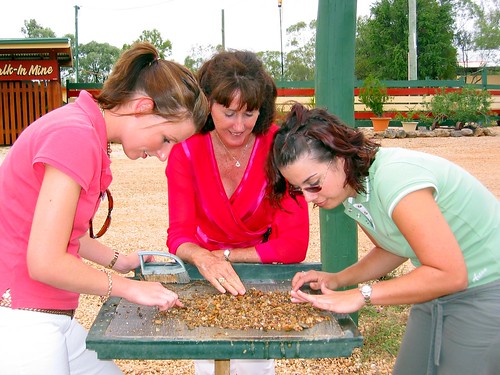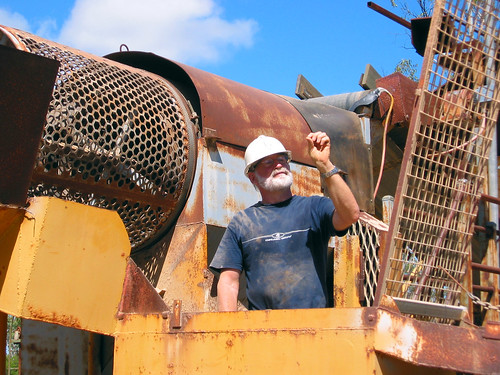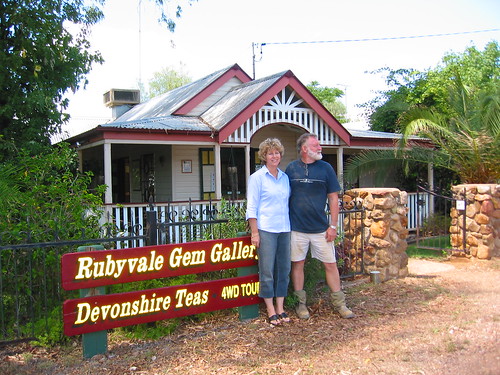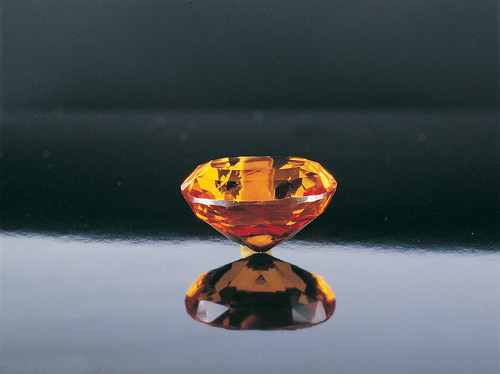
“Here you go,” says Kym with a cultured tone not often found in the Australian outback. Her finely manicured hands load a fat pile of “wash” into my sieve with a rough, well-used shovel. This where my search for a sapphire begins; with a pile of dirty gravel.
"Back in 1979, Smiley Nelson was walking home from school across the some of the fields mined by the big commercial operators,” says Tony, our guide, “and he kicked up a huge yellow sapphire weighing 2019 carats. It passed through a number of owners in the intervening years and I recently heard that it sold as a 1,400 carat, cut stone in New York for $1.2 million.”
I take the sieve, about the size of a big Frisbee, and plunge it into a 44 gallon drum full of water, jiggling and bouncing it vigorously just below the surface. This action, I’m told, washes off the clay dust and helps sort the stones into like densities. The theory is the valuable stuff will end up in the centre. Next, the whole lot is upended carefully onto a sorting bench.
Picking through the little coloured stones, my heart leaps in excitement as a produce a mighty bauble about the size of a garden snail. Kym takes about a half second to assess it and tosses it into the bush without a second look. “Quartz, darling … worthless. Keep looking.”
My delicate city fingers, used to no more mistreatment than a feather-touch computer keyboard, are soon painfully abraded and stinging. But wait, what’s this? A little pale pinkish stone peeps out from between two coarse chunks of ironstone. It’s my sapphire.
Kym and husband Dale operate the Miners Heritage, the region’s largest walk-in mine for tourists and, lucky me, I can have my new found gem cut and set while I take the underground tour with Dale. Deep in the bowels of the mine, the temperature is a constant 25 degrees, but the hard toil can have you working up a sweat in no time. Dale jabs at the coloured bands of gravel embedded in the walls with the end of his pick.
“These ancient creek beds are where you’ll find the best stones,” says Dale, “washed together after thousands of years of rain, long before man walked these lands.”
The Miners Heritage is one of several tourist mines in the region, catering to the waves of itinerant travellers passing through in search of weekend fun or even a small fortune.

Peter Brown was one such chap. Back in the late ‘70s, he arrived in Rubyvale in a smoking old Volkswagen combi and was immediately gem struck. Today, he and wife Eileen operate the award-winning Rubyvale Gem Gallery in town. Inside their homely cottage is a showroom more like a big city boutique with shiny display cases full of lustrous gems in their 22 carat settings and gift boxes. Instead of fossicking buckets and gift shop trickets, Eileen serves Devonshire tea and there is even a small cabin for overnighters. Behind the counter, Peter cuts and sets the stones extracted from his private mine nearby. “Let’s go take a look,” he says.
Unlike the Miners Heritage, Peter’s mine is not for casual visitors. We don hard hats and clamber down the rickety metal ladder. “You’ll need to duck here. Watch out.”
Further in we are presented with his piece de resistance; his grotesque pneumatic digger. Around the corner a generator throbs away, providing life to this mechanical cave monster. “Stand back,” he warns, and the beast erupts into a fierce crescendo of vibration, devouring chunks of the grotto wall which tumble onto the floor like a messy Cyclops munching giant fruit cakes.
The show’s not over and in rolls a little metal dump truck, obediently gathering up all the soil and rocks in a noisy, robotic performance. The self-powered unit ambles and stumbles erratically along a makeshift underground railway before disgorging its load into a vertical bucket shaft that transports the material to the surface where an even bigger, uglier monster awaits.
Peter’s surface rig is something out of Mad Max. This bizarre junkyard sculpture shakes the very ground it stands on as the tonnes of dirt and rocks are violently sorted in a painfully loud drum-rolling process that culminates in a trickle of pebbles on a small conveyor belt. The contraption is shut down after just a few minutes and Peter inspects the output, picking up a satisfying lump that immediately brings a smile to his dusty jowls. “That’s a good day’s work,” he announces, “that’ll make a thousand dollar piece.”
If it were only that easy, and back at the rustic and authentic Rubyvale Hotel we share a few yarns with the crusty locals over a beer and enormous steak. These guys, weathered and tempered by the ferocious dust and heat, are the sort of blokes you’d cross the street to avoid, but we manage a cautious discourse after shouting a few cold ales. The story everyone loves to tell, each with their own personal twist, is the tale of the Autumn Glory, a 100 carat rough stone that when cut to a 30 carat gem, revealed a completely unique stone of a highly unusual golden honey colour.
“This bloke, down on ‘is luck, turned up ‘ere one day about 15 years ago,” says Jack through thin, sunburned lips. Even as a fellow Aussie, I have trouble understanding his thick accent as he barely opens his mouth for fear of inhaling a fly, “and waddaya know, ‘e finds this flippin’ brute in a lizard ‘ole – by accident!”
Apparently this guy, Wal Shadworth, was completely intoxicated by his find, turned down several offers and finally is convinced it will sell overseas for much more. He sends it off to some shady dealer in Texas and never sees it again. The hunt for the lost “Autumn Glory” continues to this day. Another stone, a 1000 carat rock, was found by a 14 year old in 1935 and was finally cut to become the famous 700 carat “Black Star of Queensland” in 1948 after being used as a doorstop in the family home.
With my beer laden belly sore from constant laughing, I wander to my cabin and awake in the morning to find the discomfort shifted to my head. Over a sombre, but hearty breakfast back in the pub, we muse over the peculiar allure that sends folk crazy, plunges them underground for years on end, turning them into burrowing hermits who shun civilisation in the quest of few rocks. This scenario is enacted all over Australia. From the historic 19th century goldfields of Victoria and New South Wales to the infamous subterranean opal towns of Coober Pedy and Lightning Ridge, man’s lust for dust continues unabated.
Back in the Land Rover, we head back to the airport in Rockhampton, but swing by the Miners Heritage to collect my trinket. Kym extracts a delicate pendant setting from the velvet bag, and the little violet stone winks at me with a tiny flash of light. I’m not about to throw it all in to go live in a cave, but the beauty of this modest gem, is undeniable. Mmm … maybe there’s a bigger one in that bucket over there?

<<>>
Where: Rubyvale, Queensland Central Highlands. 300 kilometres west of Rockhampton.
Best time to visit: Annual Gemfest in neighbouring Anakie each August. [www.gemfest.com.au]
Where to stay: Rubyvale Hotel and Cabins Ph: +61 7 4985 4754
royalhotelrubyvale@bigpond.com
Regional information:
www.capricorntourism.com.au
<<>>

What is a Sapphire?
Sapphires belong to the family of precious gemstones that includes rubies, emeralds and diamonds. Rubies are actually red sapphires created by chromium impurities in the sapphire’s aluminium oxide composition, while emeralds are beryllium aluminium silicate with chromium and exclusively green.
Sapphires, while commonly regarded as a blue gem, can actually occur in a wide range of colours. Purple are lower grade, while pink or salmon coloured gems fetch higher prices than regular blue stones. Diamonds are exclusively carbon in composition and their unique crystal (allotrope) is the hardest naturally occurring material but not the most valuable, which is the ruby. Cut Sapphires are valued at about A$10,000 per carat.
Sapphires are created deep inside the Earth and brought to the surface through volcanic action. The Central Queensland Gemfields, situated around the appropriately named towns of Emerald, Rubyvale, Sapphire, Anakie and the Willows Gemfields, is the most productive area in the world for beautiful sapphires. Here the stones can be found on or just below the surface and in ancient alluvial beds as a result of explosive distribution many million years ago. This is ideal for casual fossickers.
<<>>
The author wishes to acknowledge the assistance of Mr Tony Walsh and the staff at Capricorn Tourism, Rockhampton, in the creation of this story.



